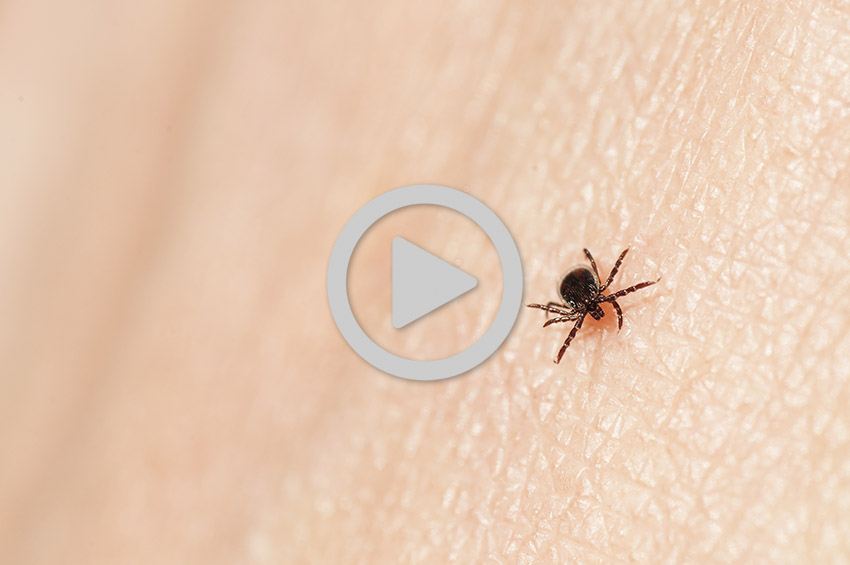Get Outside: Understanding and Avoiding Tick Encounters
Don’t let ticks prevent you from exploring the great outdoors. Professor Marten Edwards shares tips to keep you healthy and safe.By: Kristine Yahna Todaro Friday, August 2, 2019 11:22 AM
.jpg) Marten Edwards, professor of biology, conducts tick research alongside Thomas Yanushefski '18.
Marten Edwards, professor of biology, conducts tick research alongside Thomas Yanushefski '18.Spring 2020 Update
Due to the coronavirus pandemic, please follow local government regulations when visiting any local, state and national parks and green spaces, including practicing social distancing and wearing masks where required or recommended. In addition, early symptoms of a tick-borne infection may be a fever or headache and could resemble COVID-19 symptoms. Therefore, this season it is especially important to seek medical attention for any sudden changes in health and let your health care provider know that you have been outdoors and may have been exposed to a tick bite.
The Lehigh Valley region is blessed with easy access to numerous and beautiful naturally forested areas, including city, county and state parks, many of which are laced with well-marked hiking trails. Don’t let ticks stop you from enjoying these extraordinary areas.
Professor of Biology Marten Edwards has been studying the risks that ticks pose to Lehigh Valley residents for nearly 10 years. The results of his most recent research, carried out with a “tick team” of seven Muhlenberg students (now all young alumni), were just published in The Journal of Medical Entomology. The report looks specifically at the types and numbers of ticks in our forested areas and what human disease agents they are carrying. Recent graduates Emily Davidson ’18, Rita Esposito ’17, Bess Fleischman ’17, Rachel Heist ’16, Julia Leep-Lazar ’18, Samantha Stuppi ’18 and Thomas Yanushefski ’18 are all co-authors of the paper, as is Assistant Professor of Mathematics James Russell, who developed the study’s statistical analysis.
Learn more: Seven Former Students Are Co-authors on Newly Published Tick Research
The bottom line? Just 30 years ago, Lyme disease was rare in our region. Not anymore. In Pennsylvania, people need to think about ticks every time they go out in the woods, says Edwards. He recommends developing a plan for dealing with ticks and sticking to it every year. Then get out there and enjoy our wild areas.
Tips to Fight Ticks:
- Blacklegged ticks (formerly known as “deer ticks”) are currently the only ticks in our region that transmit the bacteria that cause Lyme disease. Blacklegged tick nymphs are truly the villains when it comes to spreading diseases. About the size of a poppy seed, the nymphs are also hard to see. By comparison, blacklegged tick adults are about the size of an apple seed—usually big enough to see and feel before they have a chance to do any harm.
- Be extra vigilant right now. Nymphs are on a quest for blood primarily from late spring through mid-summer in the Lehigh Valley. Blood is the only thing on a tick’s menu—and the nymphs need to get a proper meal to develop into an adult.
- Tick bites and tick-borne diseases can be avoided with some planning and effort. Thomas Mather ‘77, a professor at the University of Rhode Island (URI), is the director of URI's Center for Vector-Borne Disease and its TickEncounter Resource Center, which Edwards recommends for information about preventing tick bites. Tips include:
- You have at least 24 hours to find and remove a feeding tick before it transmits Lyme disease-causing bacteria. A daily tick check at bath or shower time can be helpful in finding and removing attached ticks before they can transmit an infection.
- If you spend a lot of time outdoors, permethrin-treated clothing, such as Insect Shield® brand tick-protective clothing, can prevent tick bites and can last through 70 washes.
- Spray boots with Sawyer® brand Permethrin insect repellent spray and pant legs with insect repellent containing DEET. Ticks don’t jump or fly but rather latch onto shoes, socks and pants when people brush up against foliage, then crawl upwards.
- If you are bitten, the easiest and safest way to remove a tick is with a pointed tweezer.
- Edwards demonstrates the technique in this Runner’s World video.
- See your doctor if you experience flu-like symptoms in the summer. They can be an early symptom of Lyme disease.
- Not all tick bites are equally risky with respect to Lyme disease so it’s important to tell different kinds of ticks apart. Edwards recommends the identification page on the Tick Encounter website to learn more.
- For example, larger American dog ticks lurk in more open grassy areas. Fortunately, they do not transmit the bacteria that cause Lyme disease.

